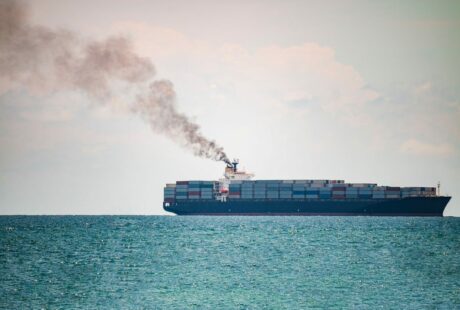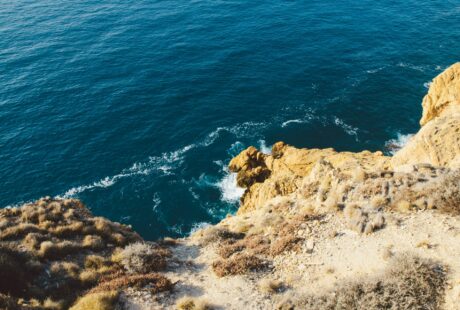As this week’s virtual meeting of the International Maritime Organization’s Pollution Prevention and Response Sub-Committee (IMO, PPR 8) closes today, non-governmental organisations slammed the IMO proposal to develop weak non-binding “goal-based guidelines” instead of taking immediate and effective action to immediately reduce climate-warming emissions of black carbon from ships using heavy fuel oil in the Arctic [1].

“The Clean Arctic Alliance is completely shocked and bitterly disappointed by the decisions taken by IMO Member States during PPR 8, which will leave the IMO fiddling around with ineffective voluntary action, while the Arctic meltdown continues”, said Dr Sian Prior, Lead Advisor to the Clean Arctic Alliance. “Having completely buried their heads in the sand, the IMO and its Member States now need to watch out for rising waters.”
“ By proposing a slow, weak and voluntary approach to tackling black carbon emissions, the IMO and its Member States have squandered this week’s golden opportunity to curb shipping’s climate impacts in the Arctic, instead of taking ambitious and urgent action to immediately drive down these emissions”, she added. “In effect, the planned ‘goal-based guidelines’ proposed during PPR 8 means that each country can take its own approach to reducing black carbon emissions, on its own time-scale, with no requirement for implementation or enforcement if indeed they choose to do anything at all”.
“After 11 years of dithering, the UN body which claims to have the mandate for addressing shipping’s climate impacts is simply running out of time. Instead of taking meaningful measures to address the threat of black carbon emissions from shipping to the Arctic ecosystem – including its wildlife, communities and summer sea ice – the IMO has today ensured that the shipping industry will continue contributing to the impacts of climate heating in the Arctic with consequences for the whole planet”.
“It is very disappointing to again witness the IMO delay pursuing sound climate policies for my Arctic home”, said Austin Ahmusak, Kawerak Marine Advocate, Nome, Alaska. “By taking action to reduce black carbon and use cleaner fuels, the IMO could have a measurable positive impact on the warming of the Arctic in the near future. This would positively benefit human health, and provide humanity, as stewards of this region, more time to address the larger human-caused warming that we must all face” [2].
The Clean Arctic Alliance, a coalition of 21 international non-governmental organisations, had earlier this week called on the IMO to seize the chance to reduce climate-warming emissions of black carbon from ships currently using heavy fuel oil in the Arctic by some 44%, by switching them to cleaner distillate fuels [3,4].
The Clean Arctic Alliance continues to call for a mandatory measure requiring all ships operating in and near to the Arctic to switch to distillate fuels or other cleaner fuels, which result in lower levels of black carbon emissions and allow the use of particulate filters, as happens with road vehicles, to further reduce the black carbon released into the atmosphere. Ultimately, the Clean Arctic Alliance believes it necessary for all shipping to move from oil-based fuel to other cleaner fuels or other methods of propulsion.
“When today’s decision is considered by PPR 8’s parent committee, MEPC – this June, the IMO must make it clear that urgent action is not only needed to reduce to black carbon emissions – but also that this action must be taken, and taken rapidly”, concluded Prior [5].

ENDS
Papers submitted to PPR 8 relating to Black Carbon:
https://imoarcticsummit.org/category/publications/imo-papers/ppr-8/
Infographics: How Black Carbon Emissions from Shipping Impact The Arctic
https://www.hfofreearctic.org/en/2021/03/08/black-carbon-facts/
Webinar Video: Switching Fuel – How to Cut Black Carbon Emissions from Arctic Shipping
About Black Carbon and Heavy Fuel Oil
Around the world, ships typically burn the cheapest and dirtiest fuel left over from the oil refining process – heavy fuel oil (HFO), which produces high levels of black carbon when burned. In January 2020, a new fuel standard was introduced by the IMO requiring ships’ fuels to contain no more than 0.5% sulphur leading the development and use of so-called very low sulphur fuels (VLSFOs) [6].
Although these fuel blends contain both heavy and lighter fuels, most will still be classed as HFO since they exceed the density limit used in the definition of HFO. About 7-21% of global shipping’s climate warming impacts can be attributed to black carbon – the remainder being CO2 [5]. When emitted by ships in and near the Arctic, black carbon particles enter the lower levels of the atmosphere, where they remain for under two weeks, absorbing heat. But when it eventually comes to land on snow or ice, black carbon’s warming impact is 7 to 10 times greater, as it reduces the reflectivity (albedo) and continues to absorb heat, accelerating the Arctic melt [7].
Although shipping only contributes 2% of the black carbon in the Arctic, it has a much greater heating impact, as other sources of black carbon are higher in the atmosphere with less chance of falling on ice and snow. While most anthropogenic sources of black carbon pollution are being reduced in the Arctic, shipping emissions of black carbon have risen 8% globally in the past decade, and in the Arctic by 85% between 2015 and 2019 alone [9]. With climate warming driving the ongoing loss of multi-season Arctic sea ice, the region is opening up to more shipping traffic; between 2013 and 2019 data published by the Arctic Council showed a 25% increase in shipping traffic and a 75% increase in the total distance sailed in the Arctic, we can expect that further increases in black carbon emissions from shipping will only further contribute to an already accelerating feedback loop [10].
In November 2020, the International Maritime Organization (IMO), the UN body which governs shipping, approved a ban on the use and carriage of HFO in the Arctic – a ban that is set to be adopted this June. Although environmental and Indigenous groups had fought for years for the Arctic to be free of HFO, this ban set to be agreed in a few months contains serious loopholes which will mean minimal reductions in the use and carriage of HFO in 2024 when implemented. Meanwhile current growth in Arctic shipping is likely to lead to an increase in HFO use and carriage in the Arctic between now and mid-2024 when the ban takes effect and further growth by mid-2029, when the loopholes will finally be closed. Under this regime, black carbon emissions are likely, for now, to continue to increase in the Arctic [11].
Notes:
[1] IMO PPR 8-J-6: Draft Revised Terms Of Reference For Further Work On The Reduction Of The Impact On The Arctic Of Black Carbon Emissions From International Shipping
[2] Kawerak Marine Program https://kawerak.org/natural-resources/marine-program/
[3] March 22, 2021; NGOs Urge Shipping Body To Halve Arctic Black Carbon Impacts By Switching Fuels
March 25, 2021: Open Letter: International NGOs Urge Global Shipping Chief to Arrest Arctic Meltdown
[4] According to the International Council on Clean Transportation’s study on the IMO’s proposed heavy fuel oil ban, HFO-fueled ships emitted 225 tonnes of black carbon in 2019. If they switched to distillate, they would have reduced their BC emissions by 44%. If so, total black carbon emissions from Arctic shipping would have fallen 30% from 356 tonnes to approximately 250 tonnes, accounting for BC emitted from all fuels. This calculation is based on the black carbon emission factors used in the Fourth IMO GHG Study.
International Council on Clean Transportation: The International Maritime Organization’s proposed Arctic heavy fuel oil ban: Likely implications and opportunities for improvement
https://theicct.org/publications/analysis-HFO-ban-IMO-2020
[5] Marine Environment Protection Committee (MEPC) – MEPC 76, June, 2021
https://www.imo.org/en/MediaCentre/MeetingSummaries/Pages/MEPC-default.aspx
[6] Global limit on sulphur in ships’ fuel oil reduced from 01 January 2020.
https://www.imo.org/en/MediaCentre/PressBriefings/Pages/34-IMO-2020-sulphur-limit-.aspx
[7] International Council on Clean Transportation, Greenhouse gas emissions from global shipping, 2013–2015
https://theicct.org/publications/GHG-emissions-global-shipping-2013-2015
IMO Submission: Consideration Of The Impact On The Arctic Of Emissions Of Black Carbon From International Shipping: Greenhouse gas emissions from global shipping 2013-2015 https://www.hfofreearctic.org/en/2017/12/01/greenhouse-gas-emissions-from-global-shipping-2013-2015/
[8] Flanner, M. G. (2013), Arctic climate sensitivity to local black carbon, J. Geophys. Res. Atmos., 118, 1840– 1851, doi:10.1002/jgrd.50176.
[9] The IMO’s proposed Arctic heavy fuel oil (HFO) ban, ICCT Fact Sheet, September 2020.
https://theicct.org/publications/analysis-HFO-ban-IMO-2020
The International Council on Clean Transportation White Paper shows that in the last four years, there has been a 19% increase in the carriage of HFO by ships operating in the Arctic and a 75% increase in HFO use in the Arctic. This has resulted in a 72% increase in black carbon emissions from ships burning HFO and a 85% increase when all shipping black carbon emissions are considered.
Comer, B., 2021. Expected black carbon emissions reductions from fuel switching. Clean Arctic Alliance PPR 8 Side Event. 22 March, 2021.
[10] Arctic Council First Arctic Shipping Status Report from PAME Working Group highlights increase in Arctic shipping traffic, 14 April 2020
[11] Nov 20, 2020: IMO and Arctic States Slammed for Endorsing Continued Arctic Pollution
About the Clean Arctic Alliance
The following not-for-profit organisations form the Clean Arctic Alliance, which is committed to a ban on HFO as marine fuel in the Arctic:
90 North Unit, The Altai Project, Alaska Wilderness League, Bellona, Clean Air Task Force, Green Transition Denmark, Ecology and Development Foundation ECODES, Environmental Investigation Agency, European Climate Foundation, Friends of the Earth US, Greenpeace, Iceland Nature Conservation Association, International Cryosphere Climate Initiative, Nature And Biodiversity Conservation Union, Ocean Conservancy, Pacific Environment, Seas At Risk, Surfrider Foundation Europe, Stand.Earth, Transport & Environment and WWF.
More more information visit https://www.hfofreearctic.org/
Twitter: https://twitter.com/CleanArctic
Posted on: 26 March 2021



